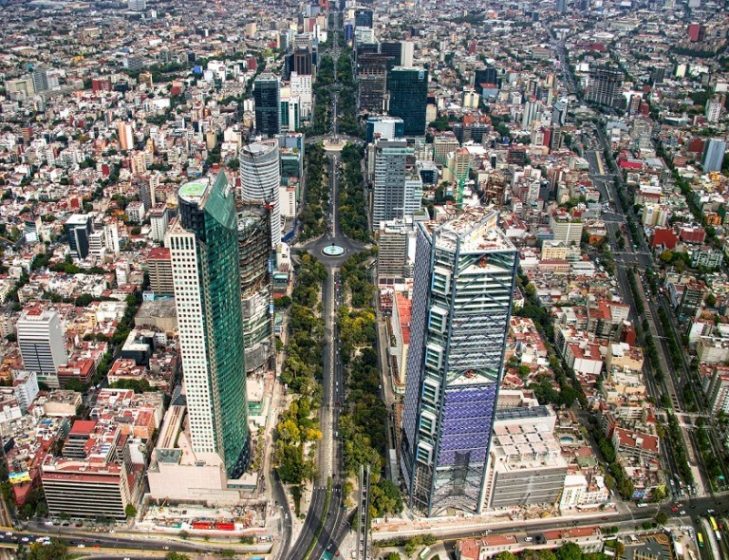For
better or worse, 2017 was a historic year for both Mexico and Mexico City. This
can be summed up in two numbers: 100 and 32. The first number celebrates the
one hundredth anniversary of Mexico’s Constitution, approved on 5
February 1917, and renowned as the first Constitution in the world to
incorporate social rights. The second number, 32, marks the remembrance of the
deadly earthquake that killed more than 30,000 people and devastated Mexico
City on 19 September 1985. Two very different anniversaries, of course. One,
but distant and hardly provoking any popular emotion; the other one random and
unforeseen, but still very present in the memories of at least three
generations.
Mexico
is a country fiercely proud of its history and traditions. Mexico City’s
current Mayor (or, more precisely, its Jefe de Gobierno—Head of
Government), Miguel Ángel Mancera, enacted and officially presented the first
local Constitution on the same day the country commemorated the first century
of the national one (although, legally, it goes into effect on 15 September
2018). Later in the year, by a tragic coincidence that challenged all
probability statistics, exactly on the same day and just a few hours after the
annual “mega-simulacro” (city-wide earthquake drill) had ended, another tragic
tremor shook several central and southern states, leaving more than three hundred
victims and thousands of buildings affected.
At
first glance, it is certainly not evident how these two very different events
are related one to another. Yet another anniversary might provide a clue for
making a connection, because 2017 also memorializes two decades of the
first-ever elected mayor in Mexico City, a milestone that opened the pathway
for a significant transformation of the political life in the city and the
country. Both the popular imagination and the academic analysis coincide in placing
the spontaneous, massive, and outstanding social mobilization that followed the
1985 disaster as one of the key ingredients in the push towards a more
democratic state with stronger civic participation.
Progressive
movements, the Right to the City, and a new Constitution
Since
then, progressive initiatives from social movements and civil society
organizations have become the norm in this megacity, and policy changes are
being implemented covering a broad range of issues, from housing and
neighbourhood betterment programs, relevant improvements in urban mobility and
sustainability, childcare and economic support for single mothers, students,
and the elderly, to sexual and reproductive rights, Indigenous peoples’ and
LGBTQ rights, to mention just a few.
The Mexico Charter for the
Right to the City (2010) is certainly a crucial part of that
legacy, as it is now the Mexico City Constitution (2017), the first one in the world to
incorporate the right to the city at the local level. It is understood as a
collective right that implies the “full and equitable use and usufruct of the
city, based on principles of social justice, democracy, participation,
equality, sustainability, as well as the respect for cultural diversity and the
respect for nature and the environment”. The right to the city should guarantee
“the full exercise of human rights, the social function of the city and its
democratic management, assuring territorial justice, social inclusion and
equitable distribution of public goods with citizen participation” (Art. 12).
Besides
this definition, the groundbreaking Constitution took several other principles
and elements from the Mexico City Charter, a document drafted inside a
collective process that included local grassroots organizations, NGOs,
activists, academics, and professionals, as well as international civil society
networks and the local government—and that also had international repercussion
in relevant documents, such as the Global-Charter Agenda for Human Rights in the City (2011) and
the New Urban
Agenda (2016), both of which explicitly recognized the right to the
city.
Promoted
as a Charter of Rights, the new Mexico City Constitution includes a long and
detailed catalogue of internationally and nationally recognized human rights
(civil, political, social, economic, and cultural rights), as well as more
“original” ones. Among them, it is worth mentioning:
– the
right to public space, as collective and participatory commons that serve
political, social, educational, cultural, and recreational functions (Art.
13.D);
– the
right to mobility, regarding access to an integrated multimodal and sustainable
public transportation system, the protection of pedestrians and the
prioritization of the non-motorized options (Art. 13.E);
– the
right to free time, as a fundamental element for well-being, allowing
inhabitants to enjoy rest, leisure, social, and recreational activities, as
well as look after their personal care (Art. 13.F).
Most
probably taking inspiration from the National Constitutions of Ecuador (2008)
and Bolivia (2009), the Mexico City Constitution also incorporates the notion
of nature as a collective entity with its own rights—and instructs the
subsequent elaboration of an ad hoc regulatory law (Art.
13.A). The recognition of the right to a healthy environment and the right to
the natural and cultural heritage for the present and future generations, as
well as the rights of Indigenous people and campesinos, are
all included in the text, while the capital of the country is recognized as a
multilingual, multiethnic, multicultural, and welcoming dynamic territory.
The
new Constitution also creates several new and complex institutions for the
city, including an Integral Human Rights System and a Democratic and
Prospective Planning System (that should be linked to each other and
incorporate substantive citizen’s participation), a local Congress, an
Economic, Social and Environmental Council and the possibility to determine
‘Municipalities’ (Alcaldías) within its territory.
To get
the text ready on time, the process of elaboration was relatively short and, at
least for some, a bit rushed. The federal political reform—a necessary step to
allow the elaboration of the Mexico City Constitution—was approved by the
Senate at the very end of 2015, after intense debate considering the details of
the capital city’s new legal status, its attributions and the related
institutional arrangements at federal, local and—somehow—metropolitan level.
In
February 2016, the Mexico City Mayor appointed a Drafting Committee and an
external Advisory Group, both integrated by a wide range of local leaders and
experts on human rights, culture, urbanism, and environmental fields. By
September 2016, the Constitutional Assembly was installed, and the Mayor
officially delivered his draft to the deputies to work on, with the last day of
January 2017 as their deadline. Finally, the first-ever Mexico City
Constitution was formally enacted on 5 February 2017, marking the one hundredth
anniversary of the National Constitution.
Who
should pay? Who should benefit? Social contract and urban planning
As
expected for any discussion of a new social contract, the process had to first
overcome some challenges and heated debates on sensitive topics. Many of them
were finally included, such as the medicinal use of cannabis, the option of
assisted suicide for the terminally ill, living wills, abortion, recalling of
elected officials (revocación de mandato), or the strengthening of
direct and participatory democracy mechanisms.

Over the past two decades, the
iconic Paseo de la Reforma has been a hot corridor of transnational
and
national real estate private investments in Mexico City valued in the
multimillions.
But
some relevant rights were left out. One of those, several observers noted, was
the issue of land-value capture (known generically as captación de
plusvalías in Spanish), considered by many experts and activists as a
fundamental instrument for the advance of urban reform and the right to the
city principles. An initial formulation was included as part of the Article 21
of Mexico City’s Draft Constitution, stating that “the increments on the land
value as a result of the urbanization process will be considered part of the
public wealth of the city. The law will regulate its use for restoring the
ecosystems and the degraded areas of the city”.
This
was not an original proposition. Similar instruments, under various names, are
being used in several countries around the world and even in other Mexican
provinces/states. Technically known as a density bonus, or up-zoning in return
for community benefits formulas (known in Spanish as transferencia de
potencialidad, contribución por mejora, derecho de edificación, etc.),
these types of planning tools have been implemented for decades in Brazil,
Canada, Colombia, the USA, France, the UK and in cities in many other
countries.
While
I’m not an urbanist or an academic in this field—nor a lawyer, by the way—in my
simple words the explanation is as follows: in exchange for the authorization
of new real estate projects, private investors and constructors must make
monetary or in-kind contributions to the city for financing infrastructure,
social housing, and other crucial needs for some specific neighbourhoods
(ideally the most disadvantaged ones) or the city/metropolitan area as a whole.
It
took some weeks—until the beginning of December 2016—but the proposal provoked
an intense and charged public debate. In just a few days, all major national
media (including print, radio, and TV) covered the issue with several dozen
news articles and interviews. As a result, by the end of the month, all mention
of the topic was totally removed from the proposal, and no reference to it was
made in the final Constitution. Additionally, any reference to the term that
was already part of the new local Housing Law, approved on those same days, was
immediately removed to avoid further debate and controversy.
Does
it sound like a coincidence? Of course it wasn’t. But what ignited the fire in
the first place? And why did it take only a few days to impact the draft of the
Constitution in such a definitive way?
The
answers to these questions are, as contradictory as it sounds, both alarming
and hopeful. Three elements make the case for it: 1) sincere concern from
ordinary citizens regarding unclear and potentially unjust norms that are
believed will affect ones personal interests and assets; 2) deliberate
manipulation from some major mass media outlets searching for polarizing
subjects, ideological indoctrination (presented, of course, as “common sense”
and “in the general interest”) and easy popularity gains (with the business/economic
benefits related to it, of course); and last but not least, 3) political
calculation from the opposition sector to discredit and attack the current
administration of Mexico City.
Regarding
reflections and lessons learned, an in-depth, detailed review is of value.
Social
mobilizations and public debates on sensitive topics
The
first element of note was an online petition, initiated by a citizen indignant
with the possibility of having the potential increases in the price of his
property taken away by the government, as an additional and
“anti-constitutional”, “hidden” property tax. Using a clearly provocative title
(“Goodbye to Private Property in Mexico City”) and hashtag
(#NoSeRobenMiPlusvalía, something that roughly translates into English as “Don’tStealMyLand-ValueIncrease”)
the petition, started on 5 December and directly addressing the Mayor and other
authorities involved in the constitutional process, sparkled intense
mobilization on social media and achieved tens of thousands of signatures in less
than forty eight hours. On its last update (13 December), the author claimed as
a collective achievement the removal of all references to land-value capture
both in the local Constitution and the local Housing Law (for more details
see https://www.change.org/p/manceramiguelmx-elimina-el-articulo-165-166-y-167-del-codigo-fiscal-de-la-ciudad-de-m%C3%A9xico-para-las-personas-f%C3%ADsicas-y-el-ciudadano-com%C3%BAn).
Lorena Zárate is
President of Habitat International Coalition. She has participated in the
elaboration of the World Charter and the Mexico City Charter for the Right to
the City.


